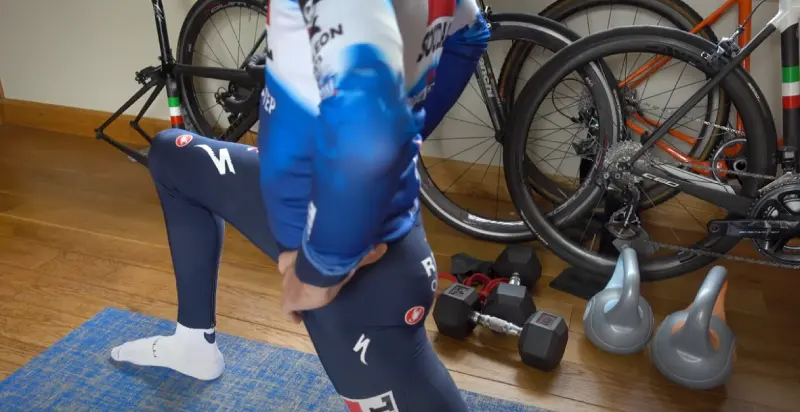Pain radiating from the back of the hip to the side of the leg can occur because of irritation of the nerve roots in the lower back. Several specific conditions, such as osteoarthritis, labral tear, greater trochanter pain syndrome, and sciatica, contribute to hip and leg pain. Dislocation of the hip, knee, or ankle can also cause discomfort in the hip and leg region.
Maintain a healthy weight to prevent hip pain, live an active lifestyle, and focus on stretching and strengthening the hip area and core. Opt for shoes that reduce foot stress and avoid excessive bending and direct pressure on the hip.
Avoid sleeping on the injured side or sitting for extended periods. Incorporate daily stretching for hip mobility, regular exercise for range of motion, and proper warm-up and cool-down routines. If pain arises, cease exercising immediately.
Our post aims to explain the causes of hip pain that radiates down to the ankle and the available treatment options.
Hip Pain Down To Ankle: 6 Causes You Shouldn’t Ignore

Hip pain radiating down to the ankle interferes with an individual’s ability to complete their daily routine, participate in sports or exercise, or even sleep comfortably. This type of pain is not only painful but also disruptive and frustrating. Various potential causes may be responsible for this type of hip pain, including:
Sciatica
Sciatica symptoms include leg or ankle discomfort resulting from irritation or compression of the nerve running from the lower back down to the legs.
Causes
A major nerve in the body, the sciatic nerve, runs through the lower back, hips, buttocks, and legs. The most common causes of sciatica include:
- Herniated or slipped discs.
- Spinal stenosis.
- Degenerated discs.
- Spondylolisthesis.
- Piriformis syndrome.
- Trauma or injury to the spine.
Treatment
Treatment for sciatica mainly depends on the severity of pain and the underlying cause of the condition. Some of the common treatments include:
- Pain medication: Over-the-counter medication like acetaminophen, ibuprofen, and naproxen can help alleviate mild to moderate sciatic pain. More vital prescription pain medication can also be prescribed for severe pain.
- Physical therapy: Exercise strengthens the muscles in the lower back and improves overall flexibility, reducing the pressure on the sciatic nerve.
- Chiropractic care: Chiropractic treatment involves spinal manipulation, which can help improve the spine’s alignment and reduce sciatic nerve pressure.
- Surgery: Surgery is considered if the sciatica pain is severe, persistent, and affecting the quality of life. Herniated discs can be removed, or the spinal canal can be widened to provide more space for the sciatic nerve.
Osteoarthritis
Osteoarthritis, a prevalent type of arthritis, often impacts joints such as the hips. This condition arises when the protective cartilage that cushions the bones in the joint deteriorates. As a result, it can lead to hip discomfort that extends down to the ankle, among other symptoms.
Causes
- Age: As we age, our chances of developing osteoarthritis increase.
- Obesity: Excess weight stresses the joints, causing the cartilage to wear down faster.
- Joint injuries: Previous injuries to the hip joint can increase the risk of developing osteoarthritis.
Treatment
- Medications: Simple analgesics like paracetamol and anti-inflammatories like ibuprofen can help with pain and inflammation.
- Exercise: Low-impact exercises like cycling, water aerobics, and walking can help improve the joints’ strength and flexibility.
- Physical Therapy: Rehabilitation can reduce joint stiffness and pain.
- Surgery: In severe cases, a prosthetic joint may need to be implanted to replace the damaged joint.
Hamstring

A hamstring is a group of three muscles on the back of the thigh from the hip to just below the knee. These muscles make extending the leg back and bending the knee possible. These muscles can be injured if stretched or overloaded beyond their limits.
Causes
- Tight or weak muscles: Hamstrings that are not properly stretched or strengthened are more likely to strain.
- Overuse or repetitive motions: Straining your hamstrings can result from repeating the same motions frequently, such as running or jumping.
- Inadequate warm-up: Failing to warm up the hamstrings properly before activity can lead to strains.
- Previous injuries: Hamstring strains can also be a result of a previous injury, which weakens the muscles and makes them more prone to strains.
Treatment
- Rest: Resting the hamstring is vital in allowing the muscle to heal. Avoid activities that cause pain or discomfort.
- Ice: Applying ice to the hamstring can help reduce pain and swelling. Ice should be applied for 20 minutes several times a day.
- Compression: Wearing compression shorts or wraps during activity can help stabilize the hamstring and prevent further injury.
- Stretching: Properly stretching the hamstring can aid in recovery and reduce the likelihood of future strains.
- Physical therapy: Strengthening muscles and preventing future injuries are possible with physical therapy.
- Medication: Ibuprofen and other over-the-counter pain relievers are effective at reducing inflammation and pain.
Piriformis
Symptoms of this condition include leg pain caused by inflammation or tightness of the piriformis muscle between the thigh bone and lower spine.
Causes
- Tightness in the piriformis muscle due to overuse or injury.
- Poor posture or body mechanics.
- Scoliosis or other spinal abnormalities.
- Muscle imbalances in the hip or pelvis.
Treatment
- Rest and ice can reduce inflammation and pain.
- Flexibility and strength exercises to improve muscle balance.
- Physical therapy to address underlying issues and promote healing.
- The spine is realigned, and nerve compression is reduced with chiropractic adjustments.
- Improve circulation and loosen tight muscles with massage therapy.
- Pain and discomfort can be relieved with medications such as anti-inflammatories or muscle relaxants.
- Surgery may sometimes be necessary to relieve severe or persistent symptoms.
Herniated Disc
It is common for herniated discs to cause pain, numbness, and weakness in different body parts, including the hips and ankles. It occurs when the soft cushioning material inside the spinal discs protrudes or ruptures through a crack in the outer layer, irritating or compressing the nearby nerves.
Causes
Although herniated discs can affect anyone, certain factors can make them more likely to occur. Some causes of herniated discs include:
- Age: As people age, their spinal discs become less flexible, more brittle, and prone to damage.
- Poor posture and mechanics: Activities that require bending, lifting, or twisting can put excessive pressure on the spine and increase the risk of disc herniation.
- Repetitive motions: Repeating the same movements repeatedly can also stress the spinal discs, causing them to bulge or rupture.
- Trauma: In some cases, a sudden injury or trauma, such as a car accident or a fall, can result in a herniated disc.
Treatment
Although herniated discs can be painful and debilitating, conservative treatments can provide relief, including:
- Rest and activity modification: The body can heal by avoiding activities that aggravate symptoms and resting.
- Physical therapy: Exercises that improve strength and flexibility, reduce pain, and prevent future injuries.
- Medications: Nonsteroidal anti-inflammatory drugs (NSAIDs) can be taken over the counter to relieve pain.
- Injections: Corticosteroid injections relieve pain and inflammation in affected areas.
- Surgery: Rarely can a disc be removed and adjacent vertebrae fused, but this option is usually reserved for severe cases.
Bursitis
The bursae, which are small fluid-filled sacs near the joints, are inflamed and painful due to bursitis. This type of bursitis is known as trochanteric bursitis because when they become inflamed, they cause pain and swelling, including the hips and ankles.
Causes
- Repetitive Motion: Certain repetitive activities may irritate or inflame the bursa. This includes activities like running, cycling, and jumping.
- Poor Posture: A bad posture adds extra pressure to joints and surrounding tissues, leading to bursitis.
- Trauma: Direct trauma to the affected area, such as a fall or a blow to the hip, can also cause bursitis.
- Arthritis: Arthritis can also cause bursitis, leading to inflammation in the joints and surrounding tissues.
Treatment
- Rest: One of the most important things you can do for bursitis is to rest the affected area. Inflammatory and painful
activities should be avoided. - Ice: Ice reduces swelling and pain in the affected area.
- Medications: Ibuprofen and naproxen, which are over-the-counter painkillers, can also help reduce pain and inflammation.
- Physical Therapy: Physical therapy can improve range of motion and strengthen affected areas.
- Corticosteroid Injections: For more severe cases of bursitis, injections of corticosteroids may be necessary.
Hip Pain Down To Ankle: 6 Prevention

Pain down the outside of the leg from hip to ankle and down the right leg from hip to ankle can arise from arthritis, bursitis, tendonitis, and other musculoskeletal conditions. Fortunately, some effective prevention methods can help mitigate the pain and avoid its progression.
- Exercise Regularly: Engaging in low-impact exercises such as walking, swimming, and cycling can significantly reduce your risk of developing pain down outside of leg from hip to ankle as you age. You can perform these exercises to strengthen the muscles around your hips, providing better support and stability to the joint.
- Watch Your Posture: Poor posture can strain your hips unnecessarily, leading to pain down your right leg from hip to ankle and discomfort. Sit and stand up straight, keep your shoulders back and head up. Avoid crossing your legs or keeping them in the same position for extended periods.
- Maintain a Healthy Weight: Extra weight can put extra pressure on your hips, making them more prone to pain down the outside of your leg from hip to ankle and injury. Pain down the right leg from hip to ankle can be reduced by maintaining a healthy weight.
- Add Supplements to Your Diet: Omega-3 fatty acids and vitamin D can help reduce joint and bone inflammation, relieving pain down the outside of the leg from hip to ankle. Before taking these supplements, talk to your doctor.
- Improve Your Range of Motion: Improve Your Range of Motion: Simple stretching and range-of-motion exercises can help maintain flexibility and improve mobility of the hips, reducing the risk of pain down the right leg from hip to ankle. These exercises should be performed under the guidance of a trained exercise physiologist or physiotherapist.
- Get Enough Rest: Inadequate rest can lead to fatigue and strain around the hip joint, causing damage and pain down the outside of the leg from hip to ankle. Get enough sleep and take regular breaks when standing or sitting regularly.
Conclusion
Various factors, such as sciatica, bursitis, or hip arthritis, can cause hip pain that extends down to the ankle. Knowing the underlying cause of your hip pain is crucial to finding the right remedy, whether stretching, exercise, lifestyle adjustments, medication, or surgery.
Don’t let hip pain hold you back from enjoying every moment of your life. Talk to your healthcare provider about the best course of action to take to regain mobility and quality of life.
Pain From Hip To Ankle When Lying Down?
An irritated lumbar or sacral nerve root can cause this type of pain, also known as sciatica. Musculoskeletal conditions, such as sacroiliac joint dysfunction or piriformis syndrome, may also cause symptoms of sciatica.

![6 Causes and Treatments of Hip Pain Down To The Ankles [6 Preventions]](https://cacyclinghub.com/wp-content/uploads/2024/03/Hip-Pain-Down-To-Ankle.jpg)
